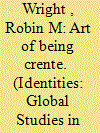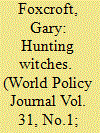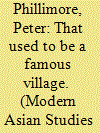|
|
|
Sort Order |
|
|
|
Items / Page
|
|
|
|
|
|
|
| Srl | Item |
| 1 |
ID:
087519


|
|
|
|
|
| Publication |
2009.
|
| Summary/Abstract |
The central objectives of this article are to describe and analyze the Baniwa Art Project, a sustainable development project based on intensive production and commercialization of basketwork, which the Baniwa Indians of the Northwest Amazon (population approximately 12,000), with the assessment of the SocioEnvironmental Institute (ISA), a major NGO in Brazil, launched in the late 1990s. The goals of this project were to enhance the value of the Baniwa basket-making tradition, increase production within the limits of the sustainable use of natural resources, generate income for indigenous producers and their political associations, and train indigenous leadership in the skills of business management. This very successful project was initiated shortly after the creation of the Indigenous Organization of the I ana River Basin (OIBI) and essentially involves 16 of the more than 100 Baniwa communities of the I ana River and its tributaries in Brazil. This article reflects on how young Baniwa evangelical political leaders, with the support of the NGO, promoted the rise of individualism, as well as the introduction of Western values of economic and political success. This generated conflicts with more "traditional" values and practices of egalitarianism producing an increase of witchcraft accusations. The case of a young Baniwa leader who coordinated both the political association and the Art Project illustrates extremely well the sorts of grave conflicts that emerged. This article will also reflect on modifications in human/spirit relations following the introduction of evangelicalism and sustainable development projects. For this, I shall cite extensively from a recent interview I conducted with a Baniwa political leader regarding his perceptions of the relations between evangelicalism, the political movement, and the meanings for the Indians of the notion of "sustainable development."
|
|
|
|
|
|
|
|
|
|
|
|
|
|
|
|
| 2 |
ID:
130830


|
|
|
| 3 |
ID:
193265


|
|
|
|
|
| Summary/Abstract |
By exploring the relationship between socioeconomic development, secularism, and the pervasiveness of traditional beliefs, this article shows that while some traditional practices and beliefs, such as making use of traditional healers, are negatively and significantly related to several development indicators, there is little to no detectable (statistical) relationship between other traditional beliefs and practices, such as believing in and seeing a jinn, and development. The evidence presented in the article sustains the claim, advanced at the turn of the millennium by Inglehart and Baker, that the impact of socioeconomic development on values, attitudes, and cultural change is complex and non-linear.
|
|
|
|
|
|
|
|
|
|
|
|
|
|
|
|
| 4 |
ID:
131775


|
|
|
|
|
| Publication |
2014.
|
| Summary/Abstract |
This paper examines the changing reputation of one village in Himachal Pradesh, India, looking back over 30 years. This village has long had a singular identity and local notoriety for its association with jadu ('witchcraft'). I argue that in this village today the idea of 'witchcraft' as a potent malignant force is losing its old persuasiveness, and with this change the village is also shedding its unwanted reputation. Against claims for 'the modernity of witchcraft' in various parts of the world, I argue that, in this case at least, witchcraft is construed as distinctly unmodern. The capacity of jadu to cause fear and, equally, its value as an explanatory idiom are, I suggest, being overwhelmed by social changes, the cumulative effect of which has been to reduce the previous insularity of this village and greatly widen the social networks of its members. I pose two main questions. Why should this village have held such a particular reputation? And why should it now be on the wane? Linked to the second question is the relationship between this decline and local understandings of 'modernity'. In developing my argument around the specificity of an unusual village, I also consider the significance of 'the village' as both social entity and, formerly, one cornerstone of the anthropological project. Finally, I reflect on the methodological opportunities of long-term familiarity with a setting, exemplified in the iterative nature of learning ethnographically, as the children known initially in early fieldwork become the adult conversationalists of today, partners in interpreting their own village's past. In exploring their explanations for the decline in the salience of jadu, the pivotal impact of education and the pressures of 'time' created by the 'speed' of modernity are both salient.
|
|
|
|
|
|
|
|
|
|
|
|
|
|
|
|
|
|
|
|
|